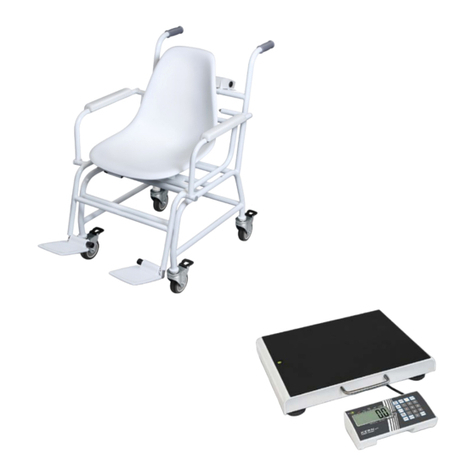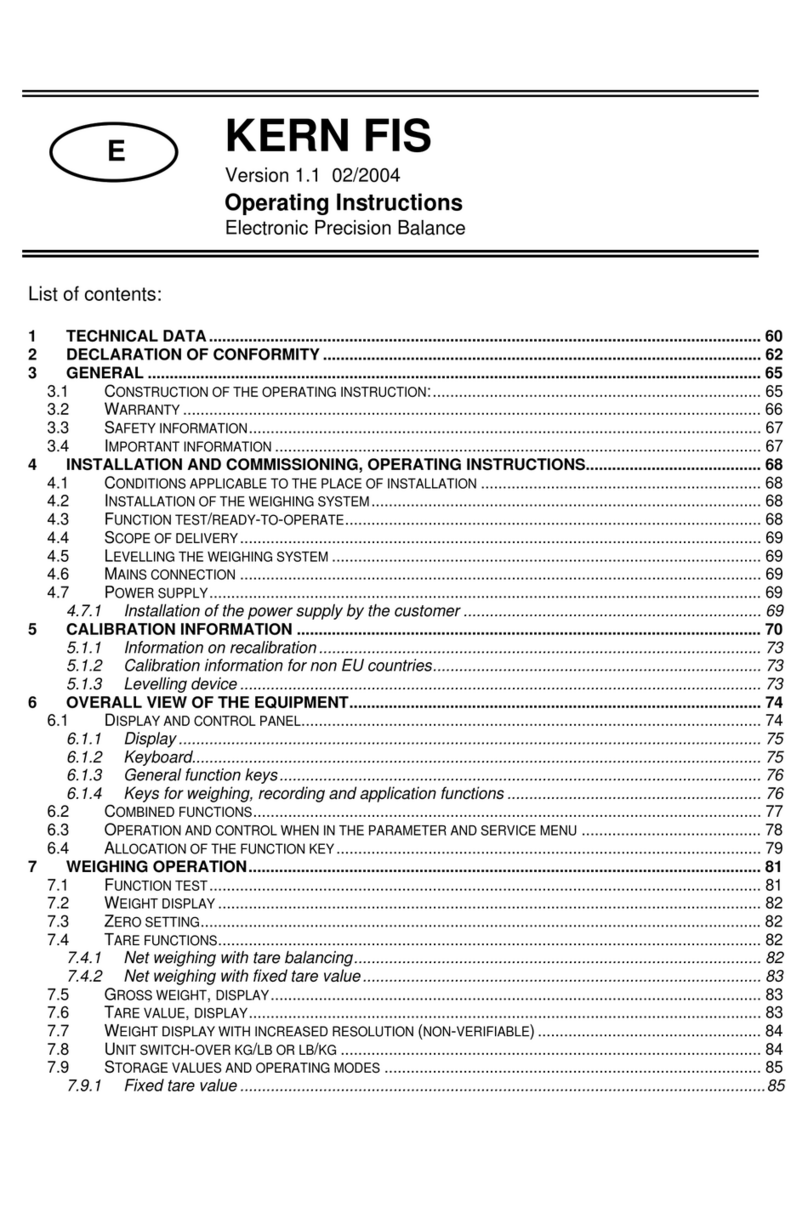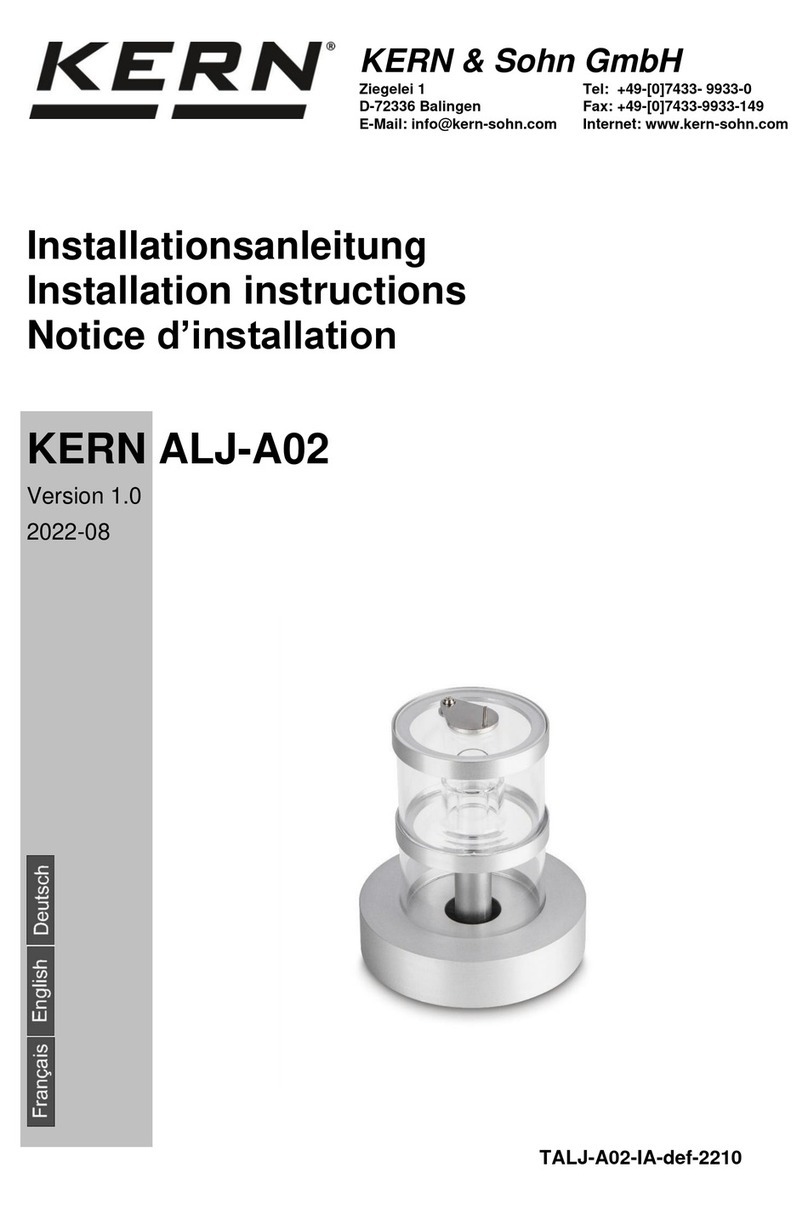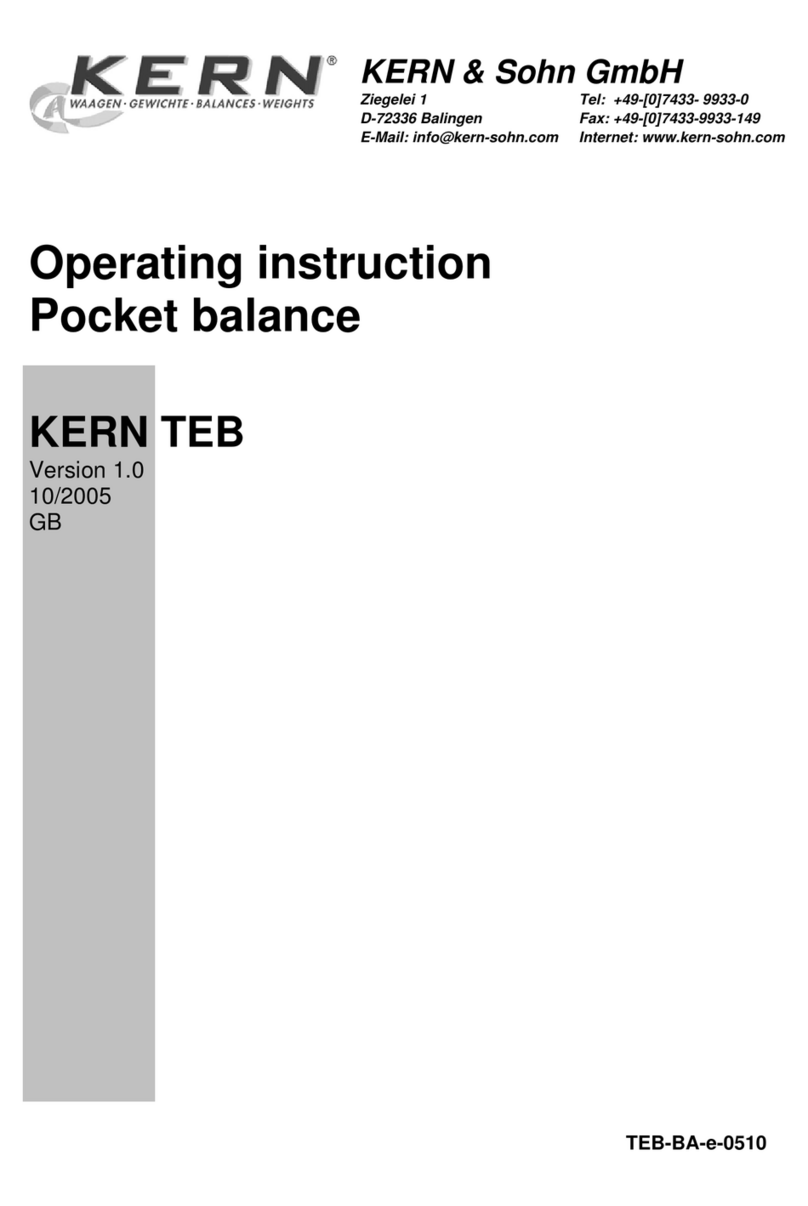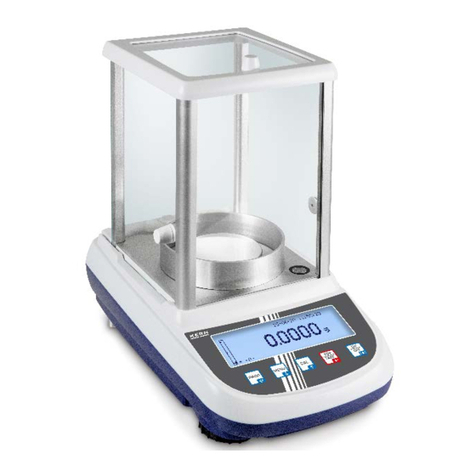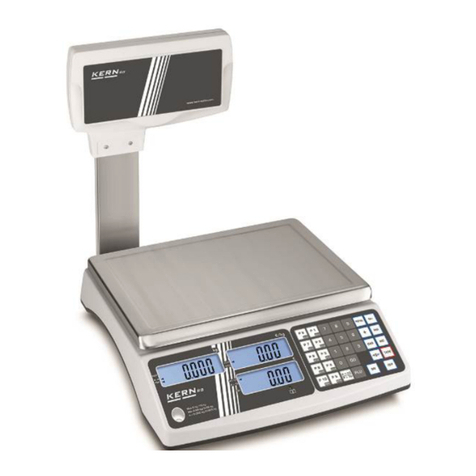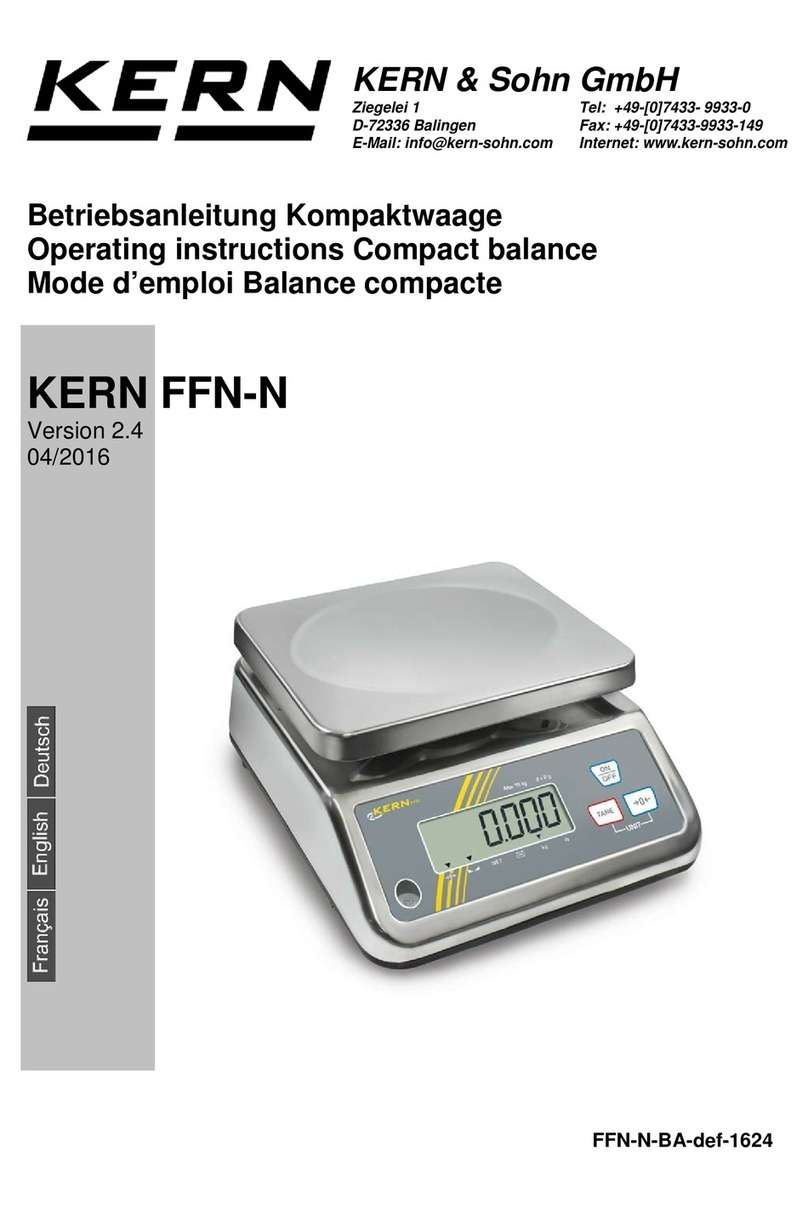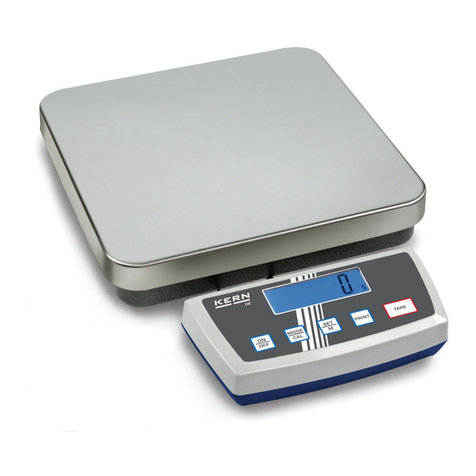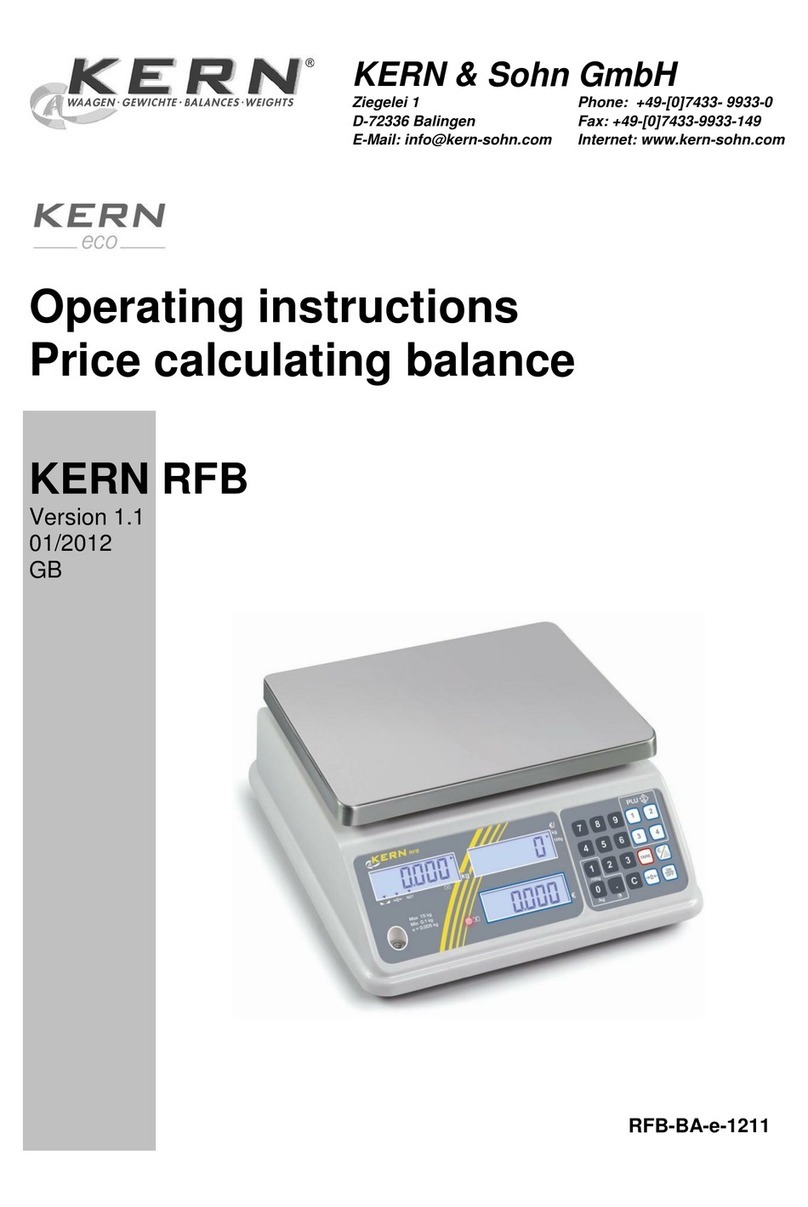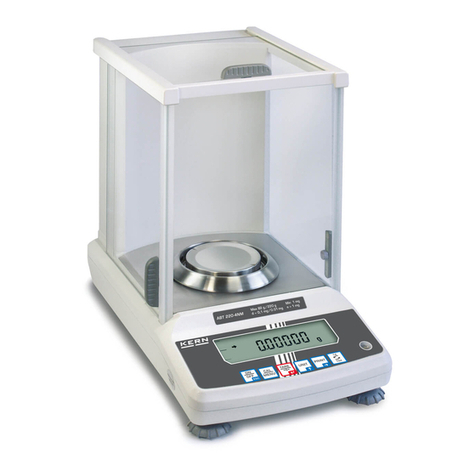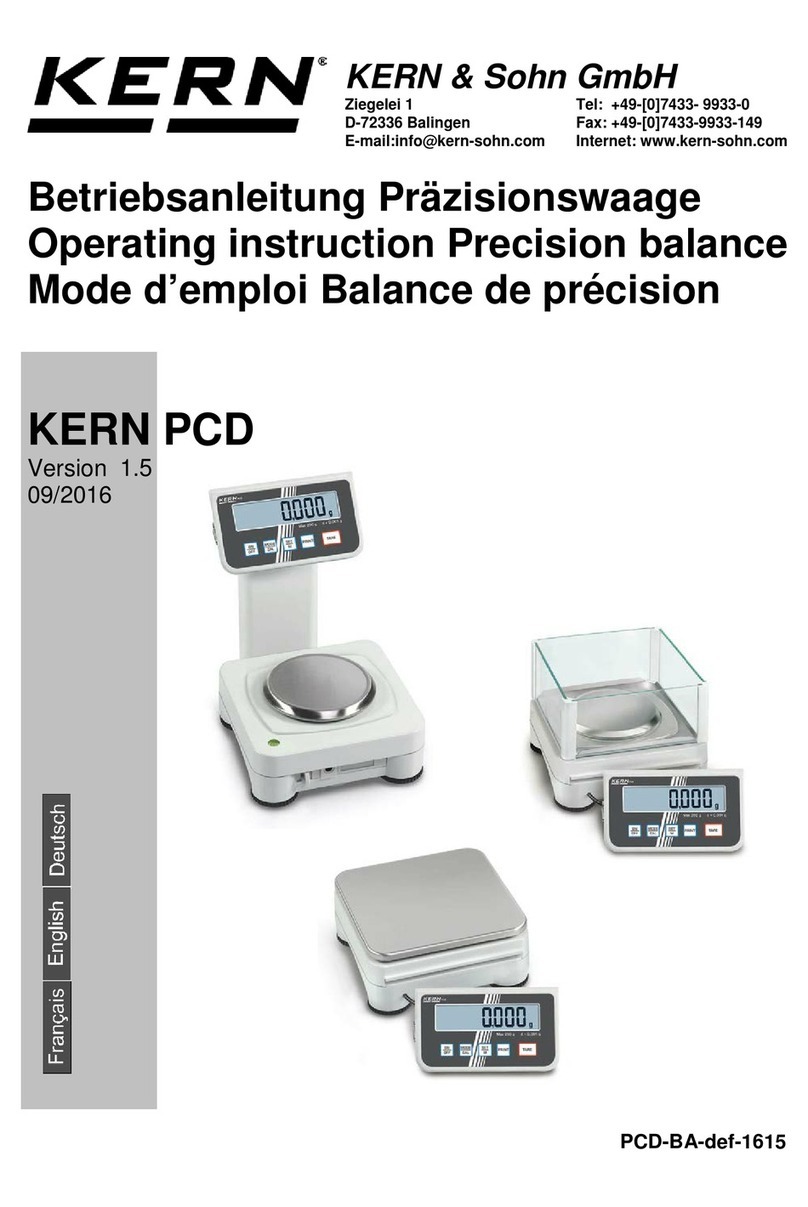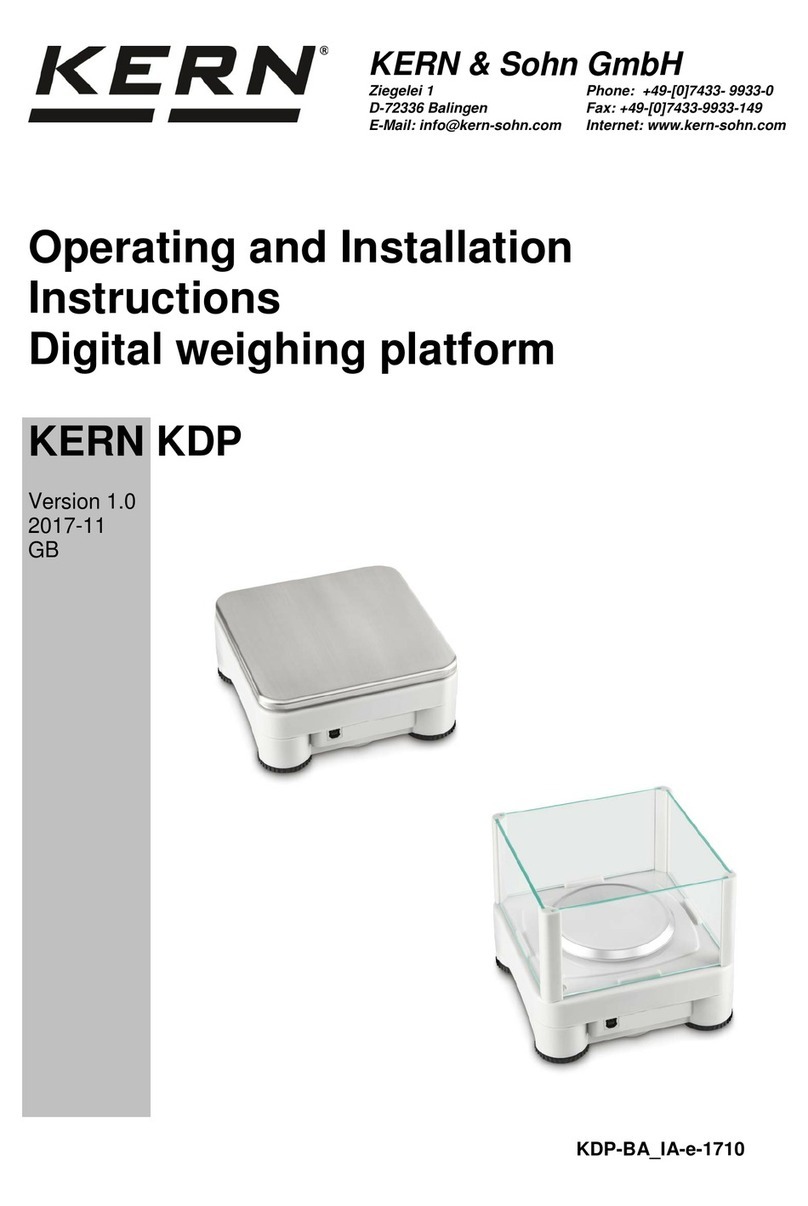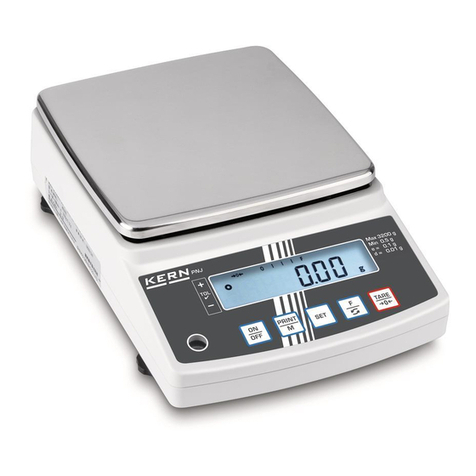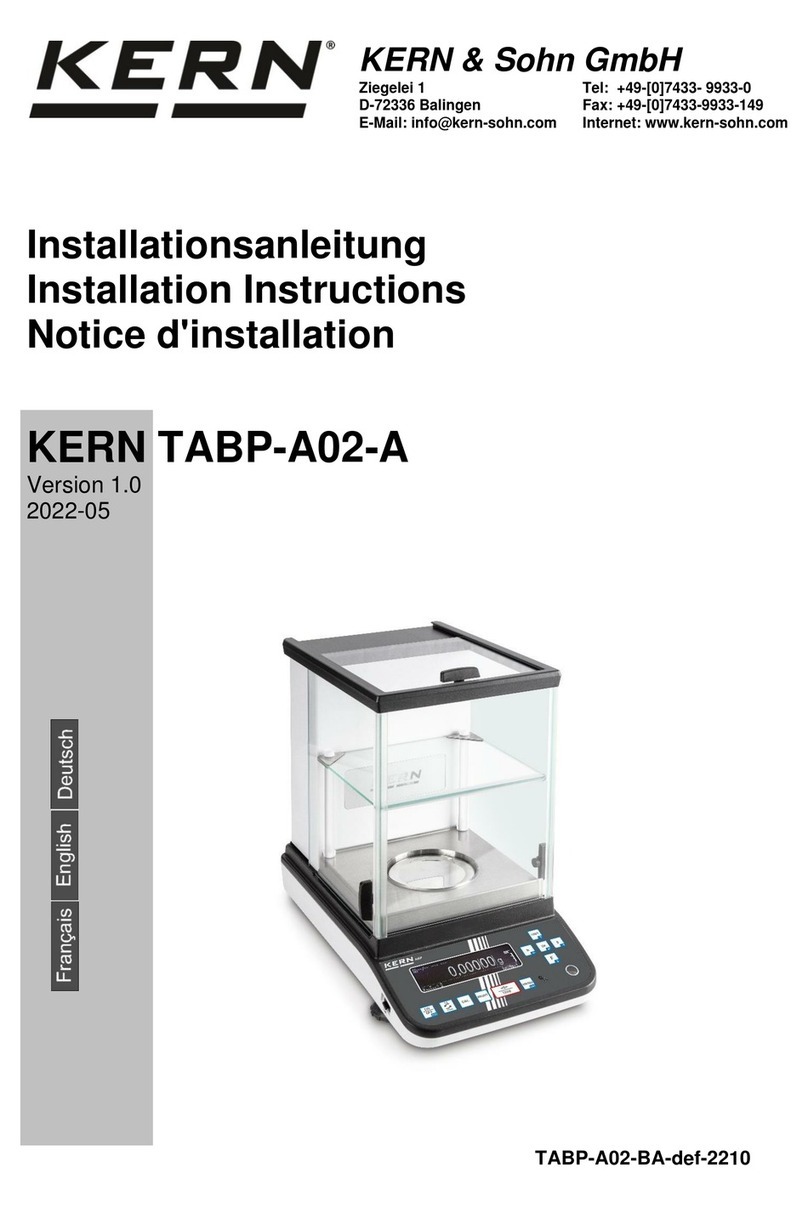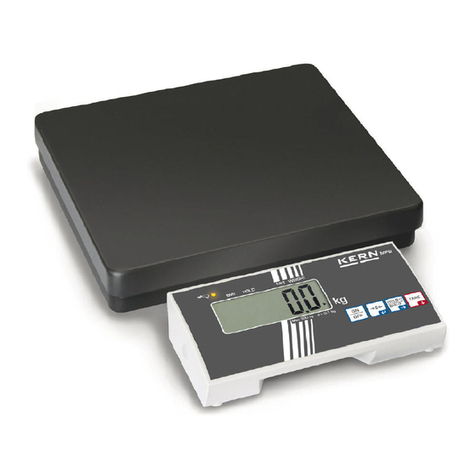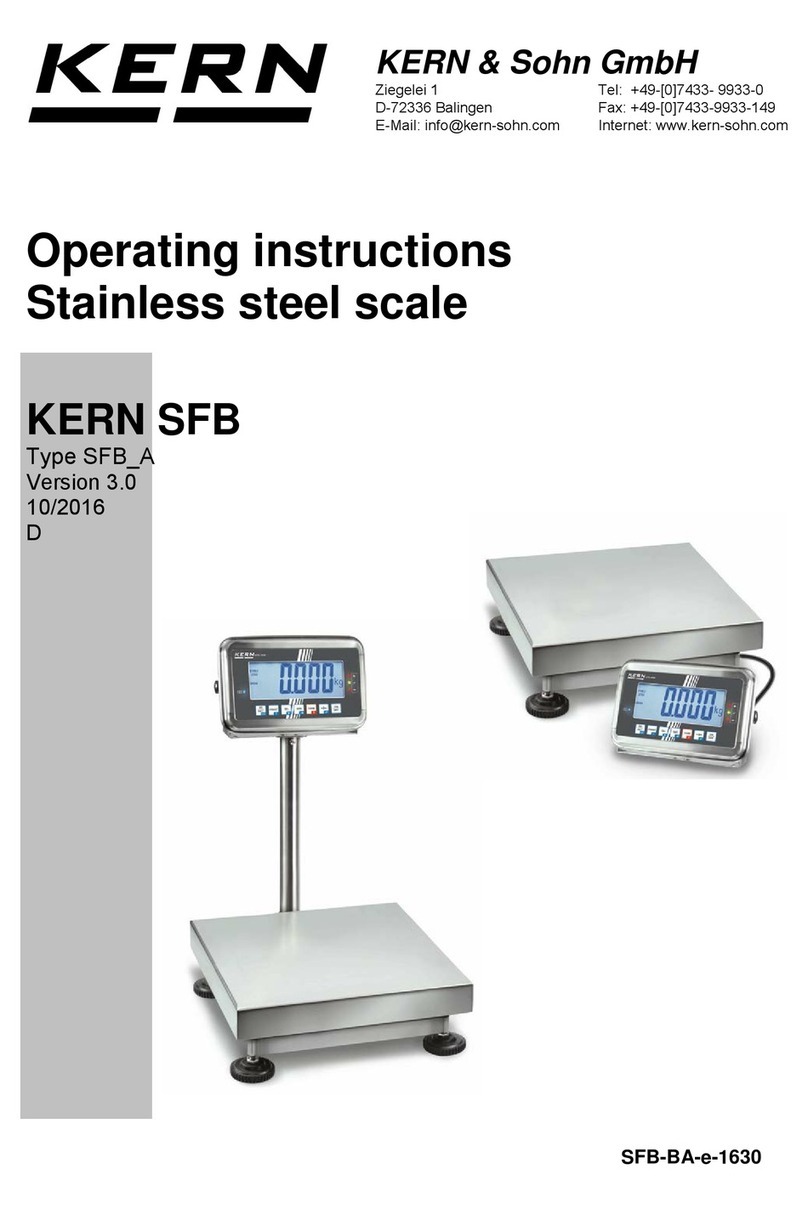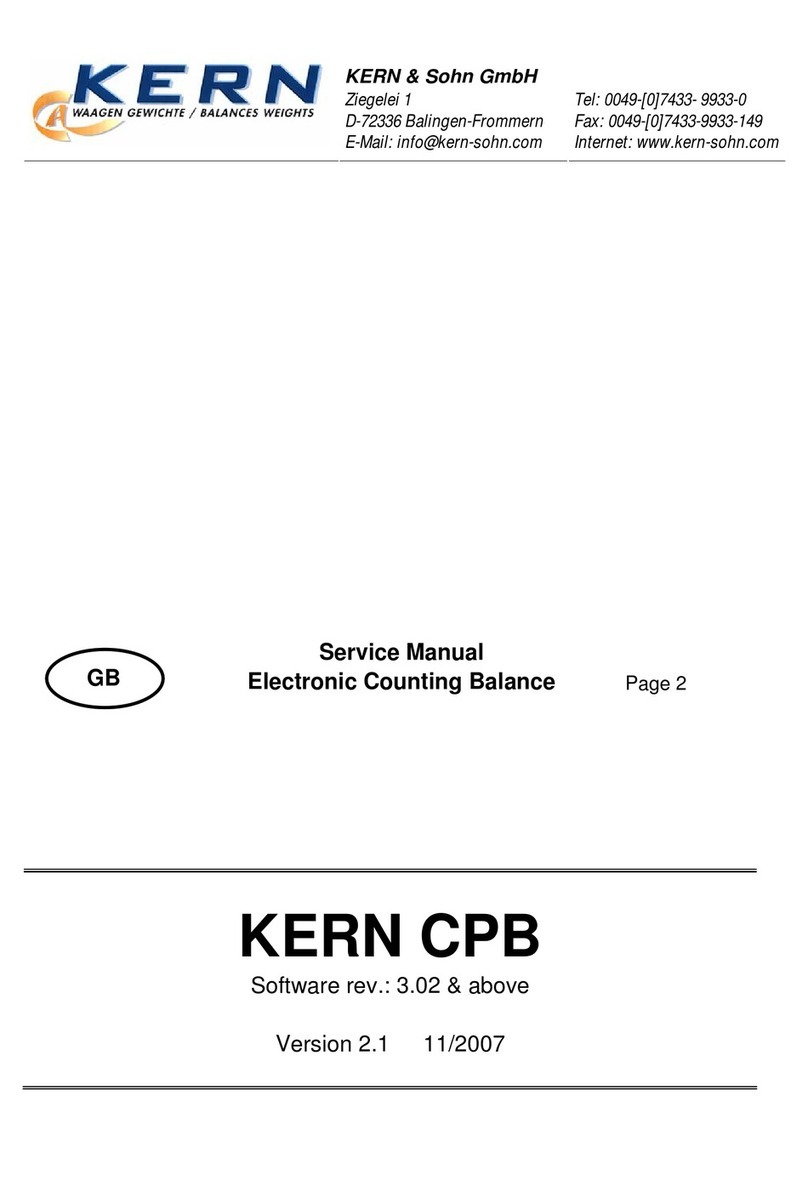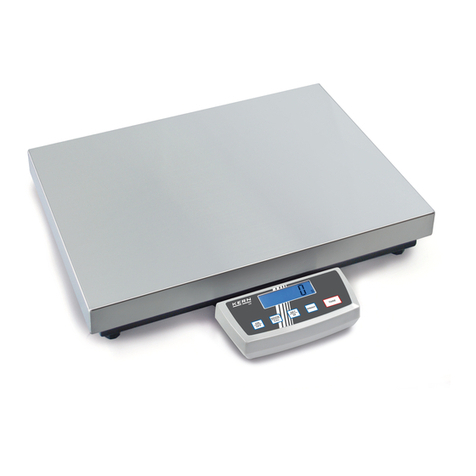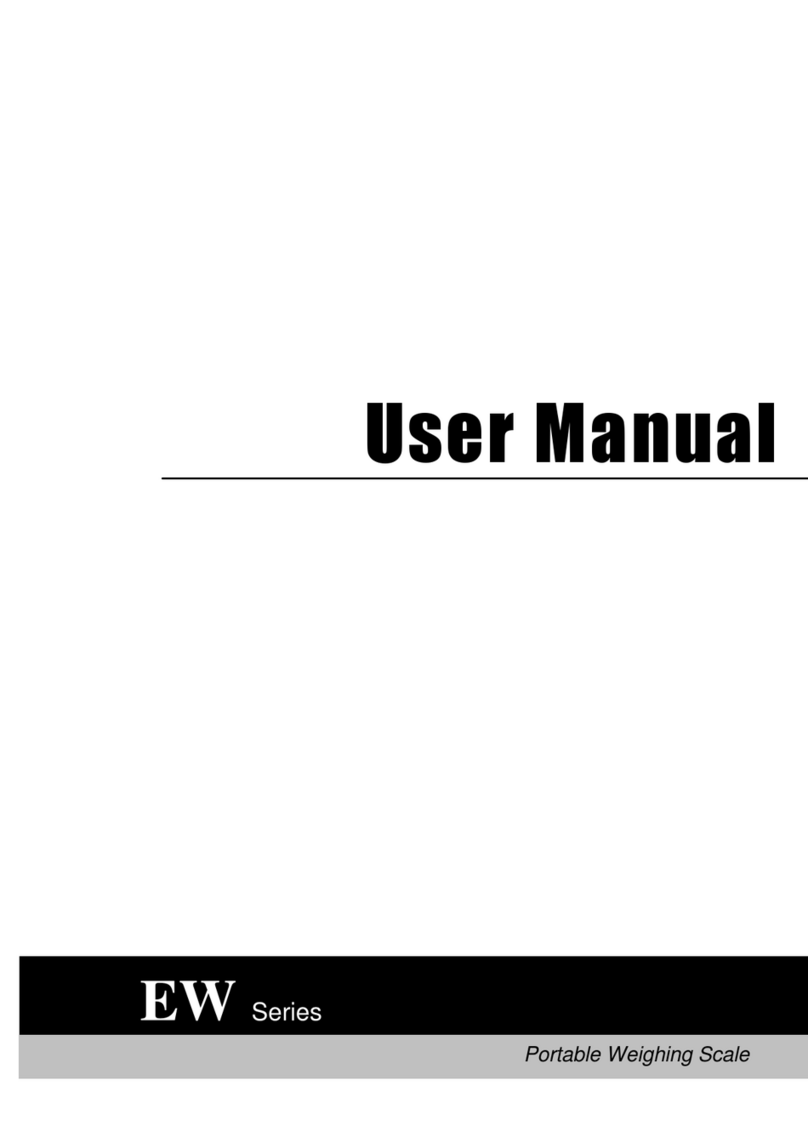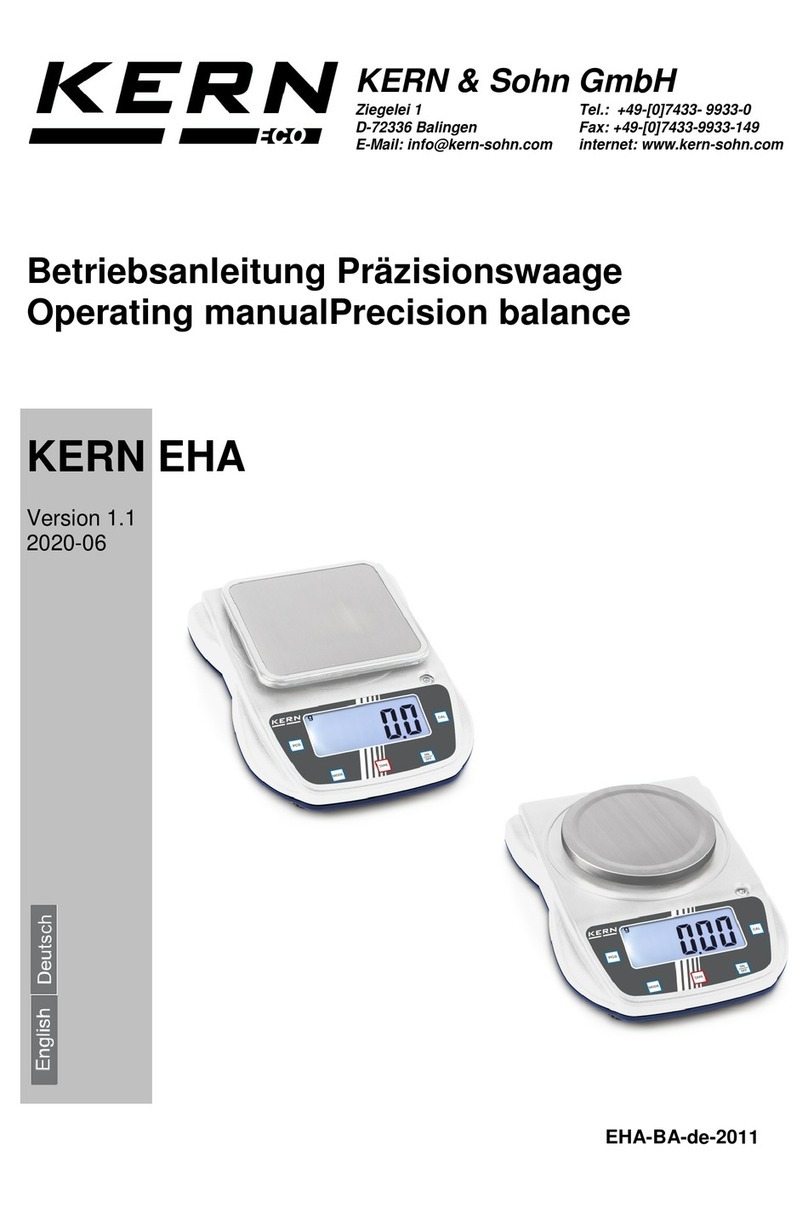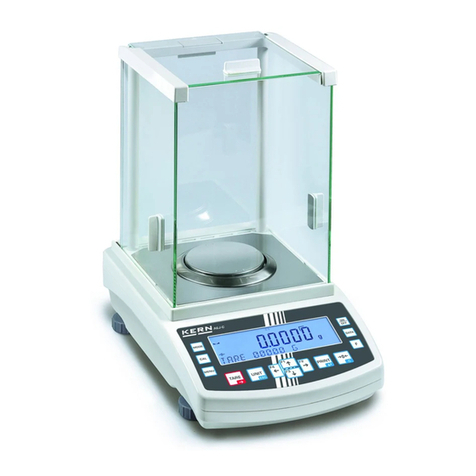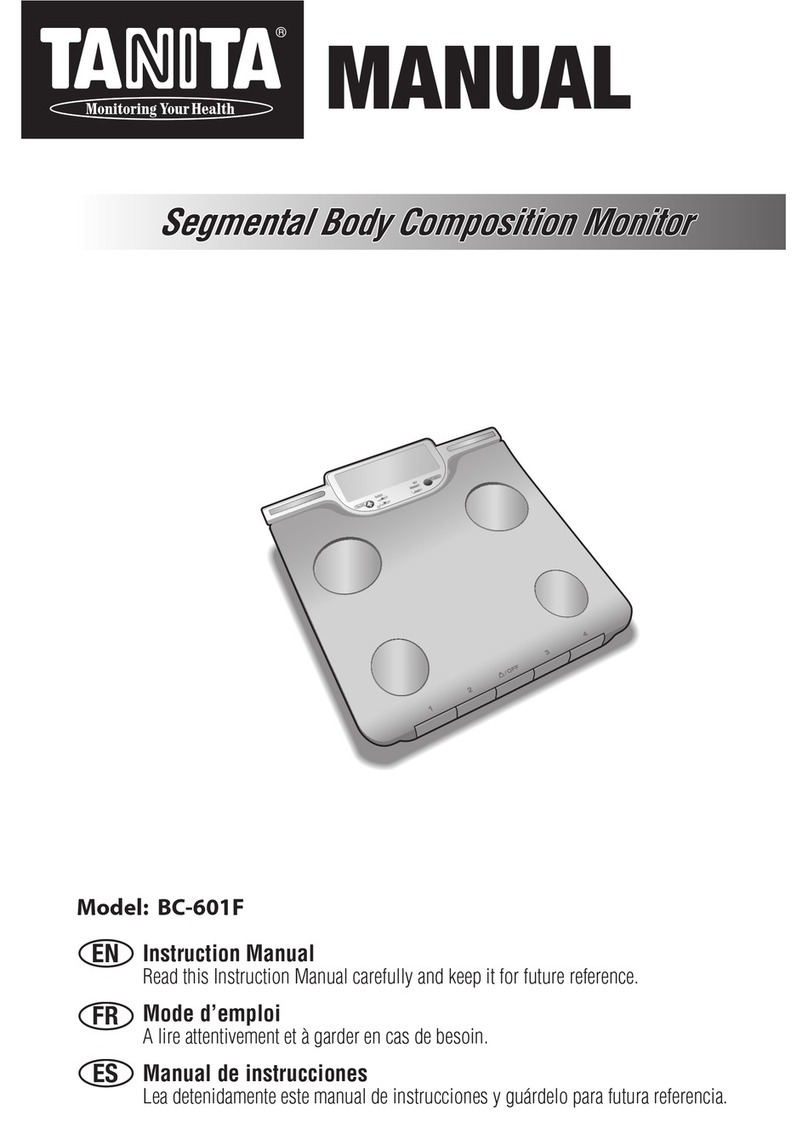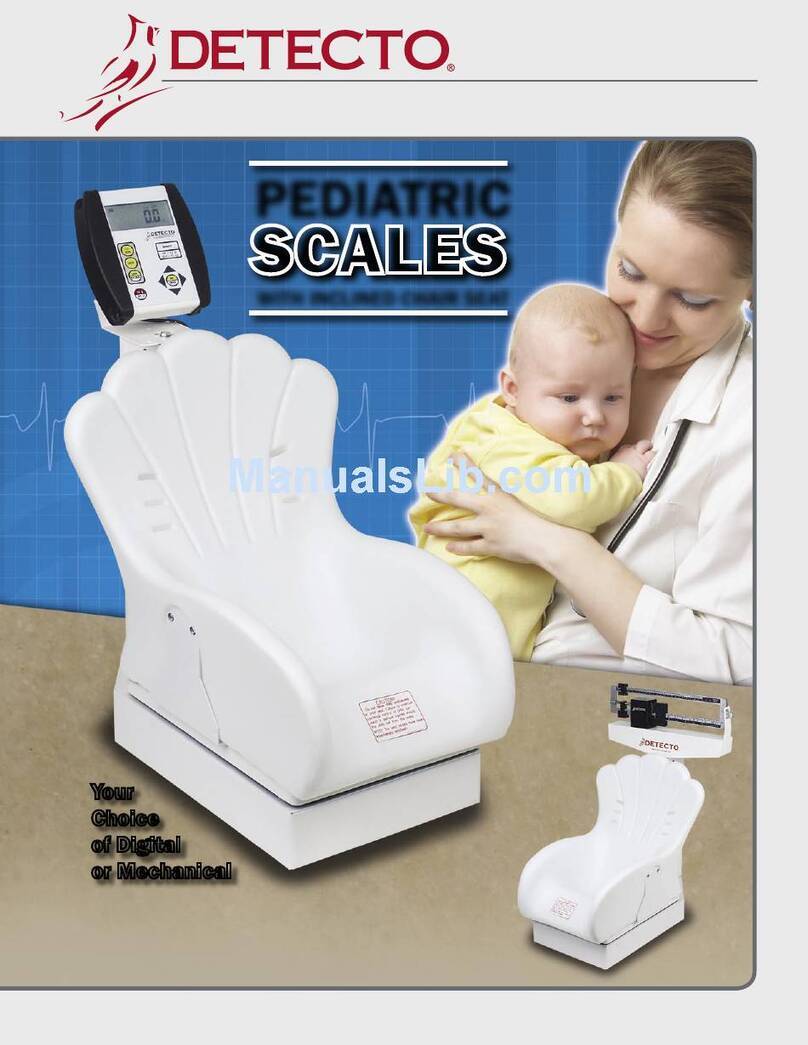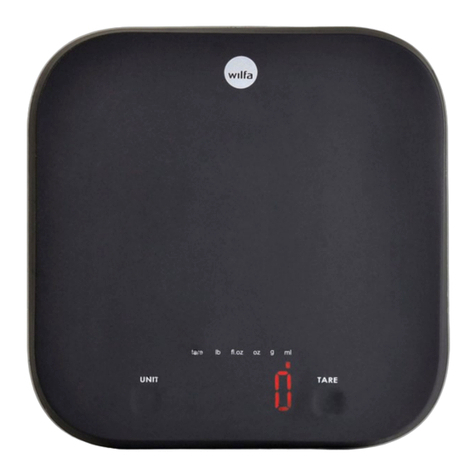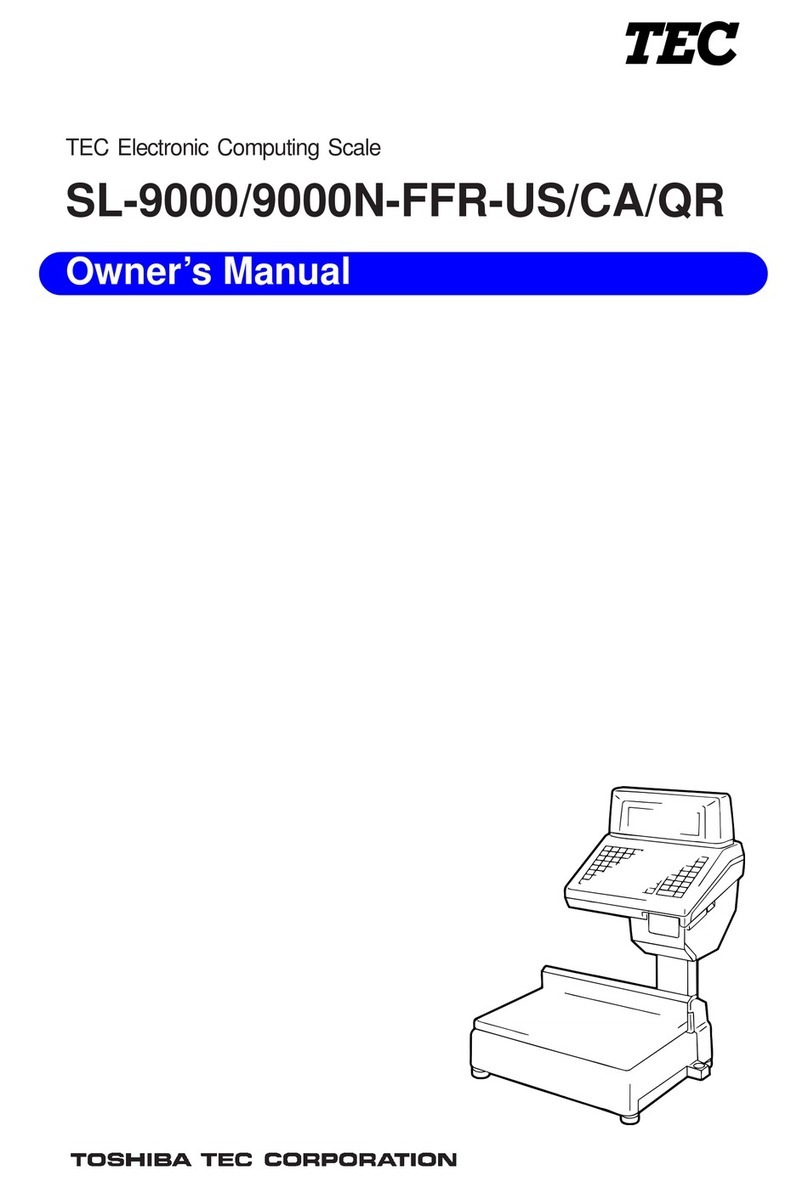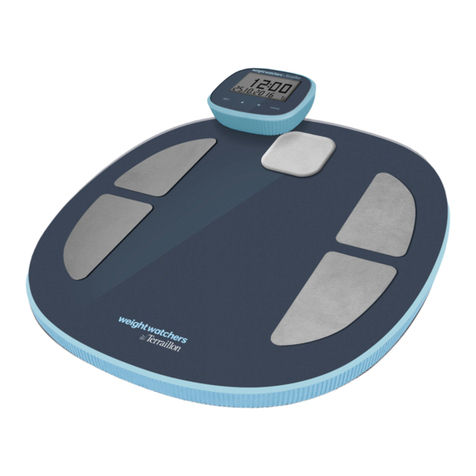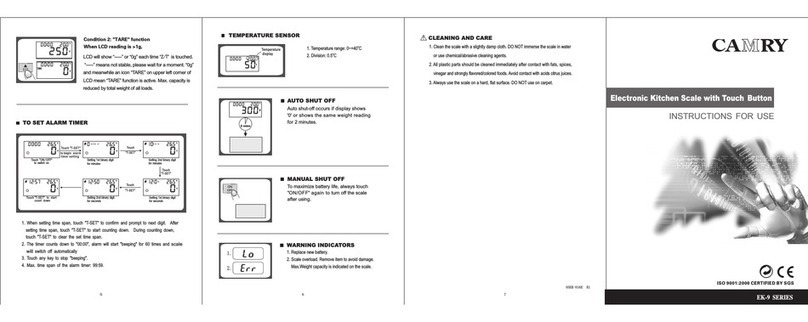KERN FKB 6K0.02 User manual

KERN & Sohn GmbH
Ziegelei 1
D-72336 Balingen
E-Mail: info@kern-sohn.com
Phone: +49-[0]7433- 9933-0
Fax: +49-[0]7433-9933-149
Internet: www.kern-sohn.com
Operating manual
Table scales
KERN FKB
Version 1.0
2020-05
GB
FKB-BA-e-2010

2FKB-BA-e-2010
GB
KERN FKB
Version 1.0 2020-05
Operating manual
Table scales
Content
1Technical data...........................................................................................................5
2Declaration of conformity ..........................................................................................8
3Appliance overview...................................................................................................9
3.1 Components.......................................................................................................9
3.2 Operating elements..........................................................................................10
3.2.1 Keyboard overview ....................................................................................10
3.2.2 Numeric entry.............................................................................................11
3.2.3 Display overview........................................................................................11
4Basic Information (General)....................................................................................12
4.1 Proper use........................................................................................................12
4.2 Improper Use....................................................................................................12
4.3 Warranty...........................................................................................................12
4.4 Monitoring of Test Resources...........................................................................13
5Basic Safety Precautions........................................................................................13
5.1 Pay attention to the instructions in the Operation Manual ................................13
5.2 Personnel training.............................................................................................13
6Transport and storage.............................................................................................13
6.1 Testing upon acceptance .................................................................................13
6.2 Packaging / return transport.............................................................................13
7Unpacking, Setup and Commissioning...................................................................14
7.1 Installation Site, Location of Use......................................................................14
7.2 Unpacking and checking ..................................................................................14
7.3 Assembling, Installation and Levelling..............................................................15
7.4 Mains connection..............................................................................................15
7.5 Battery operation (optional)..............................................................................15

FKB-BA-e-2010 3
7.6 Rechargeable battery operation (optional) .......................................................16
7.6.1 Recharge battery .......................................................................................16
7.7 Connection of peripheral devices.....................................................................17
7.8 Initial Commissioning........................................................................................17
7.9 Adjustment .......................................................................................................17
7.9.1 External adjustment <CalExt>.............................................................17
7.9.2 External adjustment with user-defined adjustment weight < caleud >.18
8Basic Operation ......................................................................................................19
8.1 Turn on/off........................................................................................................19
8.2 Simple weighing ...............................................................................................19
8.3 Weighing with tare............................................................................................19
8.3.1 Taring.........................................................................................................19
8.4 Underfloor weighing..........................................................................................20
9Operating concept...................................................................................................21
10 Application <Weighing>.......................................................................................22
10.1 Application-specific settings..........................................................................22
10.1.1 Overview.................................................................................................22
10.1.2 Description of individual functions ..........................................................23
11 Application <Counting>........................................................................................25
11.1 Application-specific settings..........................................................................25
11.1.1 Overview.................................................................................................25
11.2 Using the application.....................................................................................26
11.2.1 Parts counting.........................................................................................26
11.2.2 Check counting.......................................................................................27
12 Application <Check weighing>.............................................................................29
12.1 Application-specific settings..........................................................................29
12.1.1 Overview.................................................................................................29
12.2 Using the application.....................................................................................29
13 Menu....................................................................................................................31
13.1 Navigation in the menu..................................................................................31
13.2 Application menu...........................................................................................31
13.3 Setup menu...................................................................................................32
13.3.1 Overview < setup >...........................................................................32

4FKB-BA-e-2010
14 Interfaces.............................................................................................................36
14.1 Interface cable (RS232) ................................................................................36
14.2 Connect printer..............................................................................................37
14.3 KCP-interface commands .............................................................................37
14.4 Issue functions..............................................................................................38
14.4.1 Add-up mode < sum > ..........................................................................38
14.4.2 Data output after pressing the PRINT button < manual > .................39
14.4.3 Automatic data output < auto >..........................................................40
14.4.4 Continuous data output < cont >........................................................40
14.5 Data format ...................................................................................................41
15 Servicing, maintenance, disposal ........................................................................42
15.1 Cleaning........................................................................................................42
15.2 Servicing, maintenance.................................................................................42
15.3 Disposal ........................................................................................................42
16 Instant help..........................................................................................................43

FKB-BA-e-2010 5
1 Technical data
KERN FKB 6K0.02 FKB 8K0.1 FKB 8K0.05 FKB 15K0.5
Item no./ Type TFKB 6K-5-A TFKB 8K-4-A TFKB 8K-5-A TFKB 15K-4-A
Readability (d) 0.02 g 0.1 g 0.05 g 0.5 g
Weighing range (max) 6,000 g 8,000 g 8,000 g 15,000 g
Taring range (subtractive) 6,000 g 8,000 g 8,000 g 15,000 g
Reproducibility 0.02 g 0.1 g 0.05g 0.5 g
Linearity ± 0.06 g ± 0.3 g ± 0.15g ± 0.15 g
Stabilization time (typical) 3 sec. 2 sec. 3 sec. 3 sec.
Smallest part weight for
piece counting - under lab
conditions* 20 mg 100 mg 50 mg 1 g
Smallest part weight for
piece counting - under
normal conditions** 200 mg 1 g 500 m 10 g
Adjustment points 1 / 3 / 5 / 6 kg 2 / 5 / 7 / 8 kg 2/4/5/7/8 kg 5/10/15 kg
Recommended
adjustment weight
(not supplied) 5 kg; 1 kg (F1) 5 kg; 2 kg; 1 kg
(F1) 5 kg; 2 kg; 1 kg
(F1) 15 kg (F2)
Warm-up time 2 hrs.
Weighing Units kg, g, gn, dwt, ozt, lb, oz
Humidity of air max. 80% rel. (non-condensing)
Allowable ambient
temperature -10 °C ... + 40 °C
Input voltage Appliance 9 V, 1 A
Input voltage Mains adapter 110V – 240V AC; 50Hz/60Hz
Batteries (option) 6 x 1.5V AA
Storage battery operation
(optional)
Operating period 90 h (background illumination OFF)
Operating period 40 h (background illumination ON)
Loading time approx. 10 hrs.
Auto-Off (battery,
rechargeable battery) 3 min
Auto off (net)) Selectable 30s, 1, 2, 5, 30, 60 min
Dimensions housing 350 x 390 x 120 (W x D x H) [mm]
Weighing pan stainless
steel mm 340 x 240
Net weight (kg) 7 7 7 6
Interfaces
•RS-232 (DB9 female), as per series
•USB-appliance connection (USB B), Factory option
•Ethernet, Factory option
•
WLAN, Factory option
Underfloor weighing device yes (hook supplied)

6FKB-BA-e-2010
KERN FKB 16K0.1 FKB 16K0.05 FKB 30K1 FKB 36K0.1
Item no./ Type TFKB 16K-4-A TFKB 16K-5-A TFKB 30K-3-A TFKB 36K-4-A
Readability (d) 0.1 g 0.05 g 1 g 0.0001 kg
Weighing range (max) 16,000 g 8,000 g 30,000 g 36 kg
Taring range (subtractive) 16,000 g 8,000 g 30,000 g 36 kg
Reproducibility 0.1 g 0.05g 1 g 0.0001 kg
Linearity ± 0.3 g ± 0.15 g ± 2 g ± 0.0003 kg
Stabilization time (typical) 3 sec. 3 sec. 2 sec. 3 sec.
Smallest part weight for
piece counting - under lab
conditions* 100 mg 50 mg 2 g 100 mg
Smallest part weight for
piece counting - under
normal conditions** 1 g 500 mg 20 g 1 g
Adjustment points 5/10/15/16 kg 5/10/15/16 kg 10/20/30 kg 10/15/30/36 kg
Recommended
adjustment weight (not
supplied)
10 kg; 5 kg;
1 kg (F1) 10 kg; 5 kg;
1 kg (F1) 30 kg (F2) 20 kg + 10 kg
(E2)
Warm-up time 4 hrs. 2 hrs. 2 hrs. 2 hrs.
Weighing Units kg, g, gn, dwt, ozt, lb, oz
Humidity of air max. 80% rel. (non-condensing)
Allowable ambient
temperature -10 °C ... + 40 °C
Input voltage Appliance 9 V, 1 A
Input voltage Mains adapter 110V – 240V AC; 50Hz/60Hz
Batteries (option) 6 x 1.5V AA
Storage battery operation
(optional)
Operating period 90 h (background illumination OFF)
Operating period 40 h (background illumination ON)
Loading time approx. 10 hrs.
Auto-Off (battery,
rechargeable battery) 3 min
Auto off (net)) Selectable 30s, 1, 2, 5, 30, 60 min
Dimensions caisse
(l x L x h) [mm] 350 x 390 x 120
Weighing pan stainless
steel mm 340 x 240
Net weight (kg) 7 7 6 7
Interfaces
•RS-232 (DB9 female), as per series
•USB-appliance connection (USB B), Factory option
•Ethernet, Factory option
•WLAN, Factory option
Underfloor weighing device yes (hook supplied)

FKB-BA-e-2010 7
KERN FKB 36K0.2 FKB 65K1 FKB 65K0.2
Item no./ Type TFKB 36K-4B-A TFKB 65K-3-A TFKB 65K-4-A
Readability (d) 0.0002 kg 0.001 kg 0.0002 kg
Weighing range (max) 36 kg 65 kg 65 kg
Taring range (subtractive) 36 kg 65 kg 65 kg
Reproducibility 0.0002 kg 0.001 kg 0.0002 kg
Linearity ± 0.0006 kg ± 0.003 kg ± 0.0006 kg
Stabilization time (typical) 3 sec.
Smallest part weight for
piece counting - under lab
conditions* 200 mg 2 g 200 mg
Smallest part weight for
piece counting - under
normal conditions** 2 g 20 g 2 g
Adjustment points 10 / 20 / 30 / 36 kg 20/40/60 kg 15 / 30 / 50 / 60 kg
Recommended adjusting
weight F1 (not supplied) 20 kg; 10 kg (F1) 60 kg (F2) 50 kg; 10 kg (E2)
Warm-up time 2 hrs.
Weighing Units kg, g, gn, dwt, ozt, lb, oz
Humidity of air max. 80% rel. (non-condensing)
Allowable ambient
temperature -10 °C ... + 40 °C
Input voltage Appliance 9 V, 1 A
Input voltage Mains
adapter 100 V - 240V AC 50/60Hz 0.3A
Batteries (option) 6 x 1.5V AA
Storage battery operation
(optional)
Operating period 90 h (background illumination OFF)
Operating period 40 h (background illumination ON)
Loading time approx. 10 hrs.
Auto-Off (battery,
rechargeable battery) 3 min
Auto off (net)) Selectable 30s, 1, 2, 5, 30, 60 min
Dimensions caisse
(l x L x h) [mm] 350 x 390 x 120
Weighing pan stainless
steel mm 340 x 240
Net weight (kg) 7 6 7
Interfaces
•RS-232 (DB9 female), as per series
•USB-appliance connection (USB B), Factory option
•Ethernet, Factory option
•WLAN, Factory option
Underfloor weighing device yes (hook supplied)

8FKB-BA-e-2010
* Smallest component weight for part counting - under lab conditions:
There are ideal ambient conditions for high-resolution counting
The parts to be counted have no variation
** Smallest component part for part counting – under normal conditions:
There are unsteady ambient conditions (draft, vibrations)
The parts to be counted are subject to variation
2 Declaration of conformity
The current EC/EU Conformity declaration can be found online in:
www.kern-sohn.com/ce
For verified weighing scales (= weighing scales
assessed for
conformity) a declaration of conformity is included in the scope of
delivery.

FKB-BA-e-2010 9
3 Appliance overview
3.1 Components
Pos. Designation
1 Weighing pan
2 Display
3 Keyboard
4 Levelling screw
5 Mains adapter connection
6 Bubble level
7 Anti-theft protection device connection
8 USB-interface (Factory option)
9 RS 232 interface
10 Ethernet (Factory option)

10 FKB-BA-e-2010
3.2 Operating elements
3.2.1 Keyboard overview
Button Name Function in Operating
mode Function in Menu
ON/OFF
button
Switch on/off (press
button long time)
Switch on/off the
display background
illumination
(press button long time)
Menu level back
Exit menu / back to
weighing mode.
TARE-key
Taring
PRE-TARE
(press button long time)
Invoke application menu
(press button long time)
Navigation key
Select menu item
ZERO key Zeroing
F-key Navigation key
Select menu item
-key Switch over between
weight display and
piece quantity display
Navigation key
Activate menu item
Confirm selection
PRINT button Calculate weighing data
via interface

FKB-BA-e-2010 11
3.2.2 Numeric entry
Button Designation Function
Navigation key
Select cipher
Confirm entry. Press button repeatedly for every
digit. Wait until the numeric input window
extinguishes.
Navigation key Reduce flashing cipher (0 – 9)
Navigation key Increase flashing cipher (0 – 9)
3.2.3 Display overview
Position Display Description
1
Stability display
2 >0< Zero indicator
3
Minus display
- NET Net weight value display
4
Tolerance marks for check weighing
5
Units display / Pcs/ %
selectable g, kg, lb, gn, dwt, oz,ozt
or
Application icon [Pcs] for piece counting
or [%] for determination of percentage
6
Rechargeable battery charge indicator
- G Optional reference piece number enabled
-
∑
Weighing data can be found in the sum
memory
LO
OK
HI
5
1
2
3
4
6

12 FKB-BA-e-2010
4 Basic Information (General)
4.1 Proper use
The balance you purchased is intended to determine the weighing value of material to
be weighed. It is intended to be used as a “non-automatic balance”, i.e. the material to
be weighed is manually and carefully placed in the centre of the weighing pan. As soon
as a stable weighing value is reached, the weighing value can be read.
4.2 Improper Use
Do not use balance for dynamic add-on weighing procedures, if small amounts of goods
to be weighed are removed or added. The “stability compensation“ installed in the
balance may result in displaying an incorrect measuring value! (Example: Slowly
draining fluids from a container on the balance.)
Do not leave permanent load on the weighing pan. This may damage the measuring
system.
Impacts and overloading exceeding the stated maximum load (max) of the balance,
minus a possibly existing tare load, must be strictly avoided. Balance may be damage
by this.
Never operate balance in explosive environment. The serial version is not explosion
protected.
The structure of the balance may not be modified. This may lead to incorrect weighing
results, safety-related faults and destruction of the balance.
The balance may only be used according to the described conditions. Other areas of
use must be released by KERN in writing.
4.3 Warranty
Warranty claims shall be voided in case
•Our conditions in the operation manual are ignored
•The appliance is used outside the described uses
•The appliance is modified or opened
•Mechanical damage and damage by media, liquids, natural wear and tear
•The appliance is improperly set up or incorrectly electrically connected
•The measuring system is overloaded

FKB-BA-e-2010 13
4.4 Monitoring of Test Resources
In the framework of quality assurance the measuring-related properties of the balance
and, if applicable, the testing weight, must be checked regularly. The responsible user
must define a suitable interval as well as type and scope of this test. Information is
available on KERN’s home page (www.kern-sohn.com) with regard to the monitoring of
balance test substances and the test weights required for this. In KERN's accredited
DKD calibration laboratory test weights and balances may be calibrated (return to the
national standard) fast and at moderate cost.
5 Basic Safety Precautions
5.1 Pay attention to the instructions in the Operation Manual
Carefully read this operation manual before setup and
commissioning, even if you are already familiar with KERN balances.
All language versions contain a non-binding translation.
The original German is binding.
5.2 Personnel training
The appliance may only be operated and maintained by trained personnel.
6 Transport and storage
6.1 Testing upon acceptance
When receiving the appliance, please check packaging immediately, and the appliance
itself when unpacking for possible visible damage.
6.2 Packaging / return transport
Keep all parts of the original packaging for a possibly required return.
Only use original packaging for returning.
Prior to dispatch disconnect all cables and remove loose/mobile parts.
Reattach possibly supplied transport securing devices.
Secure all parts such as wind screen, weighing pan, power unit etc.
against shifting and damage.

14 FKB-BA-e-2010
7 Unpacking, Setup and Commissioning
7.1 Installation Site, Location of Use
The balances are designed in a way that reliable weighing results are achieved in
common conditions of use.
You will work accurately and fast, if you select the right location for your balance.
Therefore, observe the following for the installation site:
•Place the balance on a firm, level surface.
•Avoid extreme heat as well as temperature fluctuation caused by installing next
to a radiator or in the direct sunlight.
•Protect the balance against direct draughts due to open windows and doors.
•Avoid jarring during weighing;
•Protect the balance against high humidity, vapours and dust.
•Do not expose the device to extreme dampness for longer periods of time. Non-
permitted condensation (condensation of air humidity on the appliance) may
occur if a cold appliance is taken to a considerably warmer environment. In this
case, acclimatize the disconnected appliance for ca. 2 hours at room
temperature.
•Avoid static charge of goods to be weighed or weighing container.
If electro-magnetic fields or static charge occur, or if the power supply is unstable major
deviations on the display (incorrect weighing results) are possible. In that case, the
location must be changed.
7.2 Unpacking and checking
Remove device and accessories carefully from packaging, remove packaging material
and install the device at the planned work place. Check if that there has been no
damage and that all packing items are present.
Scope of delivery / serial accessories:
•Balance, see chap. 3.1
•Mains adapter
•Operating manual
•Protective cover
•Flush-mounted hook

FKB-BA-e-2010 15
7.3 Assembling, Installation and Levelling
Remove the four transport securing devices above the supports of the weighing
pan
Install weighing pan and wind shield if necessary.
Ensure that the balance is installed in a level position.
Level balance with foot screws until the air bubble of the water balance is in the
prescribed circle.
Check levelling regularly
7.4 Mains connection
Select a country-specific power plug and insert it in the mains adapter.
Check, whether the voltage acceptance on the scales is set correctly.
Do not connect the scales to the power mains unless the information on
the scales (sticker) matches the local mains voltage.
Only use KERN original mains adapter. Using other makes requires
consent by KERN.
Important:
Before starting your weighing balance, check the mains cable for
damage.
Ensure that the power unit does not come into contact with liquids.
Ensure access to mains plug at all times.
7.5 Battery operation (optional)
When the batteries are exhausted, in the display will appear <instab>.
Rotate the balance carefully in a way that the bottom of the balance is freely
accessible.
Open the battery compartment and exchange the batteries.
Ensure correct polarisation.
Close again the lid.
•To save the battery, in menu (see chap. 13.3.1.) the automatic switch-off
function <Autoff> can be activated.
•If the balance is not used for a longer time, take out the battery and store
it separately. Leaking battery liquid could damage the balance.

16 FKB-BA-e-2010
7.6 Rechargeable battery operation (optional)
ATTENTION
The rechargeable battery and the battery match with each
other. Only use the delivered mains adapter.
Do not use the balance during the loading process.
The rechargeable can only be replaced by the same or by a
type recommended by the manufacturer.
The rechargeable battery is not protected against all environmental
influences. If the rechargeablebattery isexposed tocertain
environmental influences, it may set onfire or explode. Personsmaybe
injured ormaterial damage mayoccur.
Protect the rechargeable battery against fire and heat.
Do not bring the rechargeable battery in contact with fluids, chemical
substances or salt.
Do not expose therechargeable batteryto high pressure or
microwaves.
Under no circumstances the rechargeable batteries and the charging
unit may be modified or manipulated.
Do not use a defective, damaged or deformed rechargeable battery.
Do not connect or short-circuit the electrical contacts of the
rechargeable battery with metallic objects.
Liquid may squirt out from a damaged rechargeable battery.
If the liquid gets into contact with the skinor the eyes, the skin and the
eyes may be irritated.
Ensure the correct polarity when inserting or changing the rechargeable
battery (see instructions in the battery compartment)
The rechargeable battery operation is overridden when the mains
adapter is connected. For weighing in mains operation > 48 hrs.,the
rechargeable batteriesmust be removed! (Dangerof overheating).
If the rechargeable battery starts to smell, being hot, changing
the colour or being deformed, it must be immediately unplugged
from mains supply and from the balance if possible.
7.6.1 Recharge battery
The rechargeable battery package is charged via the delivered power cable.
Before the first use, the rechargeable battery package should be charged by connecting
it to the mains power cable for at least 15 hours.
To save the rechargeable battery, in menu (see chap.0.) the automatic switch-off
function <Autoff> can be activated.
If the capacity of the rechargeable battery is exhausted, in the display <instab> will
appear. Connect the power cable as soon as possible to load the rechargeable battery.
Charging time until complete recharging is approx. 10 h.

FKB-BA-e-2010 17
7.7 Connection of peripheral devices
Before connecting or disconnecting of additional devices (printer, PC) to the data
interface, always disconnect the balance from the power supply.
With your balance, only use accessories and peripheral devices by KERN, as they are
ideally tuned to your balance.
7.8 Initial Commissioning
In order to obtain exact results with the electronic balances, your balance must have
reached the operating temperature (see warming up time chap. 1). During this warming
up time the balance must be connected to the power supply (mains, accumulator or
battery).
The accuracy of the balance depends on the local acceleration of gravity.
Strictly observe hints in chapter Adjustment.
7.9 Adjustment
As the acceleration value due to gravity is not the same at every location on earth, each
display unit with connected weighing pan must be coordinated - in compliance with the
underlying physical weighing principle - to the existing acceleration due to gravity at its
place of location (only if the weighing system has not already been adjusted to the
location in the factory). This adjustment process must be carried out for the first
commissioning, after each change of location as well as in case of fluctuating
environment temperature. To receive accurate measuring values it is also
recommended to adjust the display unit periodically in weighing operation.
•Arrange the required adjustment weight, see chap. 1.
Carry out adjustment as near as possible to the highest load of the balance
(recommended adjustment weight see chap. 1). Weights of different nominal
values or tolerance classes may be used for adjustment but are not optimal
for technical measuring. The accuracy of the adjustment weight must
correspond approximately to or, if possible, be better than, the readability [d]
of the balance. Info about test weights can be found on the Internet at:
http://www.kern-sohn.com
•Observe stable environmental conditions. A warming up time (see chapter 1)
is required for stabilization.
•Ensure that there are no objects on the weighing pan.
7.9.1 External adjustment <CalExt>
Observe stable environmental conditions. A warm up time (see chapter 1) is
required for stabilization.
Ensure that there are no objects on the weighing pan.
To invoke the setup menu press the TARE and ON/OFF button at the same time
and keep them pressed until the first menu item <Cal> will be displayed.
Navigation key Press button, <CalExt> will be displayed.

18 FKB-BA-e-2010
Navigation key Press button, the first selectable adjustment weight will be
displayed.
Use the navigation keys to select the desired adjustment weight, see chap. 1
„Adjustment points“ or „Recommended adjustment weight“
Prepare the required adjustment weight.
Acknowledge selection by button. < Zero >, < Pt ld > followed by the
weight value of the adjustment weight to be placed will be displayed.
Place the adjustment weight and confirm with button,
< wait > followed by < success > will be displayed.
After successful adjustment the balance automatically returns to weighing mode.
In case of an adjustment error (e.g. objects on the weighing pan) the display will
show the error message <wrong >. Switch off balance and repeat the
adjustment process.
7.9.2 External adjustment with user-defined adjustment weight < caleud >
Observe stable environmental conditions. A warm up time (see chapter 1) is
required for stabilization.
Ensure that there are no objects on the weighing pan.
To invoke the setup menu press the TARE and ON/OFF button at the same time
and keep them pressed until the first menu item <Cal> will be displayed.
Navigation key Press button, <CalExt > will be displayed.
Use the navigation keys to select < caleud >.
Confirm with button. The numeric input window for the weight value of the
adjustment weight appears.
Enter weight value and confirm using the button, numeric entry see chap. 3.2.2.
< Zero >, < Pt ld > followed by the weight value of the adjustment weight to be
placed will be displayed.
Place the adjustment weight and confirm with button,
< wait > followed by < success > will be displayed.
After successful adjustment the balance automatically returns to weighing mode.
In case of an adjustment error (e.g. objects on the weighing pan) the display will show
the error message <wrong >. Switch off balance and repeat the adjustment process.

FKB-BA-e-2010 19
8 Basic Operation
8.1 Turn on/off
Start-up:
Press the ON/OFF button.
The display lights up and the balance carries out a selftest.
Wait until the weight display appears, then the balance is ready for weighing.
Switch off:
Keep ON/OFF button pressed until the display disappears
8.2 Simple weighing
Check zero display [>0<] and set to zero with the help of the TARE–key, as
required.
Place goods to be weighed on balance.
Wait until the stability display appears ( ).
Read weighing result.
Overload warning
Overloading exceeding the stated maximum load (max) of the device,
minus a possibly existing tare load, must be strictly avoided. This could
damage the instrument. Exceeding the maximum load is indicated by
. Unload balance or reduce preload.
8.3 Weighing with tare
8.3.1 Taring
The dead weight of any weighing container may be tared away by pressing a button, so
that the following weighing procedures show the net weight of the goods to be weighed.
Put the weighing container on the weighing pan
Wait until the stability display appears ( ), then press TARE key.
The weight of the container is now internally saved. The zero display and the
indicator „TARE“ will appear. „TARE“ informs that all shown weight values are net
values.
Weigh the material.
Wait until the stability display appears ( ).
Read net weight.

20 FKB-BA-e-2010
•
When the balance is unloaded the saved taring value is displayed with
negative sign.
•To delete the stored tare value, remove load from weighing pan and
press the TARE button.
•The taring process ca
n be repeated any number of times, e.g. when
adding several components for a mixture (adding). The limit is reached
when the taring range capacity is full.
•Numeric input of the tare weight (PRE-TARE), see chap. 10.1.2.2
8.4 Underfloor weighing
Objects unsuitable for placing on the weighing scale due to size or shape may be
weighed with the help of the flush-mounted platform.
Proceed as follows:
Switch off the balance.
Open closing cover (1) at the balance bottom.
Place weighing balance over an opening.
Completely screw-in the hook
Hook-on the material to be weighed and carry out weighing.
CAUTION
•Always ensure that all suspended objects are stable enough to hold the desired
goods to be weighed safely (danger of breaking).
•Never suspend loads that exceed the stated maximum load (max) (danger of
breaking)
Always ensure that there are no persons,
animals or objects that might be damaged
underneath the load.
NOTICE
After completing the underfloor weighing the opening on the bottom of the balance
must always be closed (dust protection).
Other manuals for FKB 6K0.02
2
This manual suits for next models
8
Table of contents
Other KERN Scale manuals
Popular Scale manuals by other brands
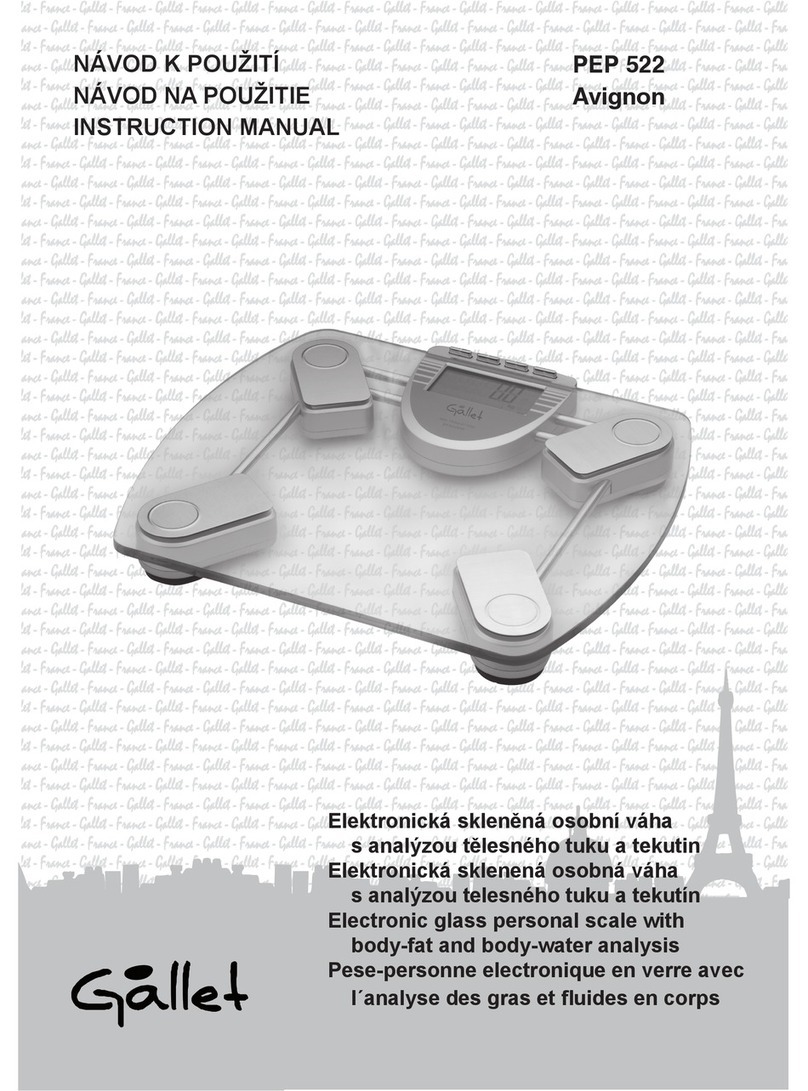
Gallet
Gallet AVIGNON PEP 522 instruction manual
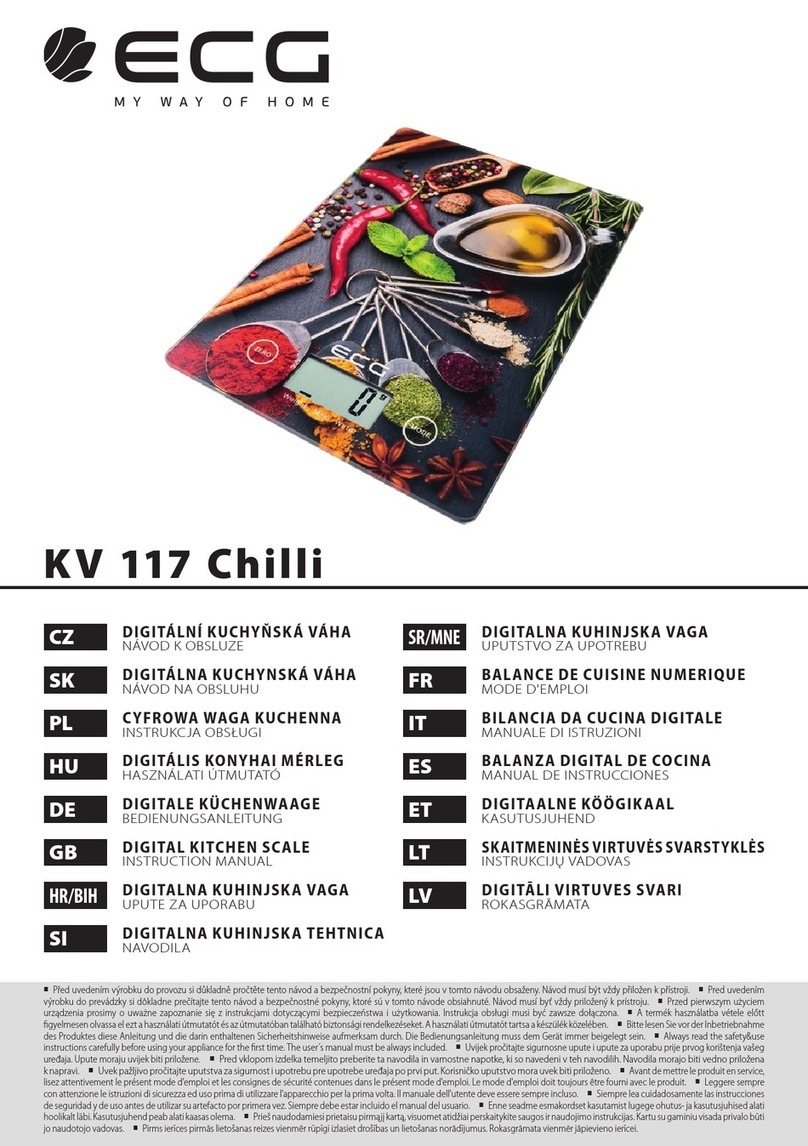
ECG
ECG KV 117 Chilli instruction manual
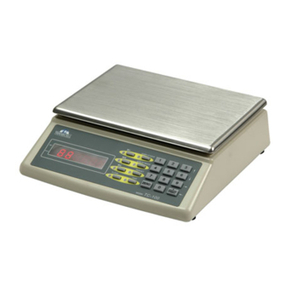
Transcell Technology
Transcell Technology TC-100 Series Operation manual
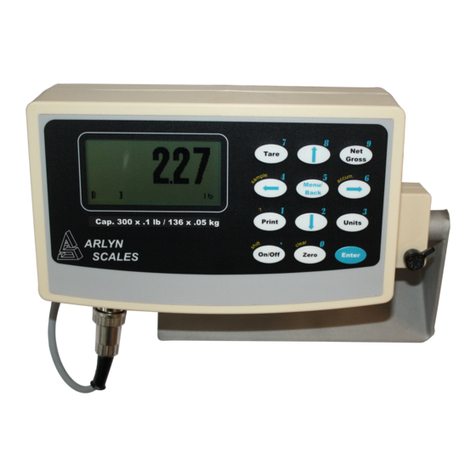
Arlyn Scales
Arlyn Scales w/MKE-5 quick start guide

Rice Lake
Rice Lake DC-190 ULTRA COUNT Operation manual
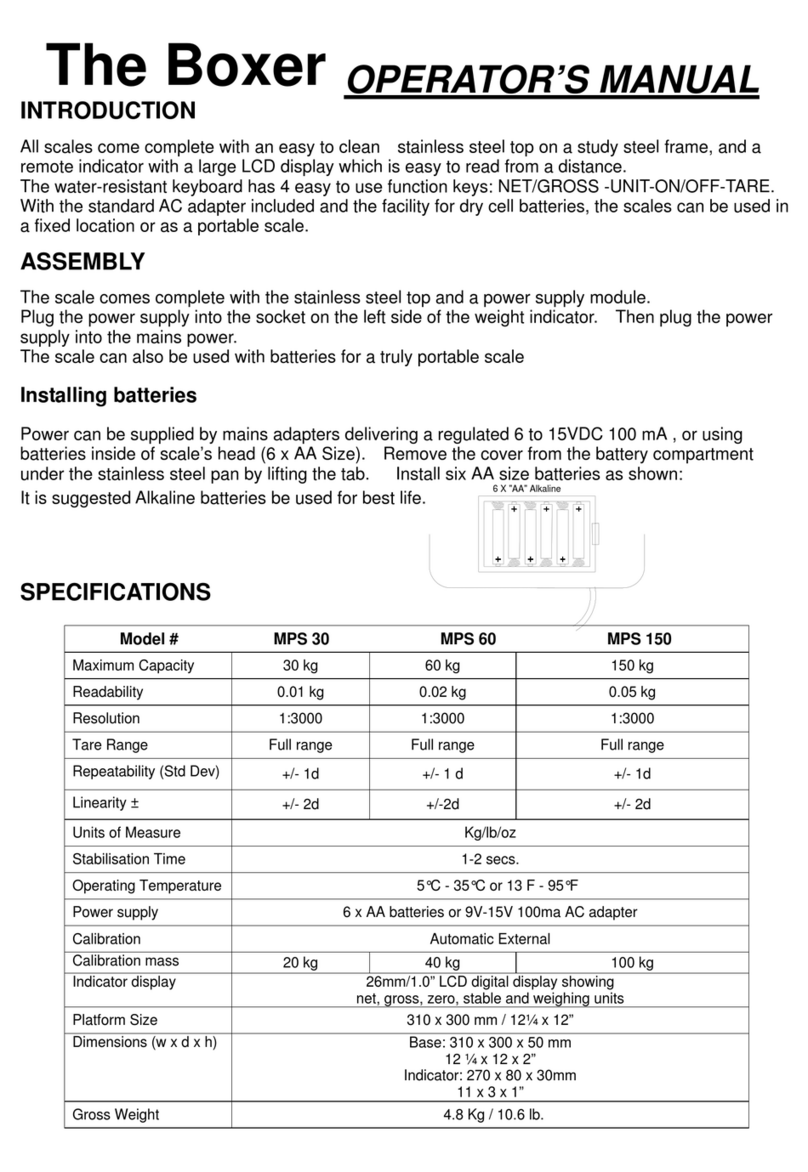
marsden
marsden Boxer MPS 30 Operator's manual
